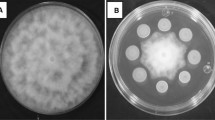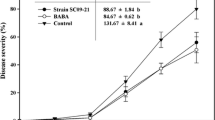Abstract
Phytophthora infestans is the pathogen of potato late blight, which is one of the most serious diseases of the potato. Myxobacteria, especially Myxococcus, become a valuable biological control resource due to their preponderant abilities to produce various secondary metabolites with novel structure and remarkable biological activity. In a previous study, Myxococcus fulvus B25-I-3 with antagonistic activity against P. infestans was isolated from an environmental sample by rabbit fecal induction method. The biocontrol mechanism of M. fulvus B25-I-3 against P. infestans and its control efficiency on potato late blight were studied. The results showed that the active substances produced by strain B25-I-3 had strong inhibitory effect on the asexual reproduction and sexual reproduction of P. infestans. In addition, the active substances could reduce the content of soluble proteins and the activity of the protective enzymes (polyphenol oxidase, peroxidase, phenylalanine ammonia lyase, superoxide dismutase) in P. infestans and increase the oxidative damage and permeability of cell membrane. And the active substances could inhibit the infection of the detached potato leaves by P. infestans significantly. In conclusion, M. fulvus B25-I-3 can produce active substances against P. infestans and has potential value to develop into biological pesticides for the control of potato late blight. The completion of this work may provide basic data for the isolation and identification of active substances and the development of pesticides against potato late blight.










Similar content being viewed by others
References
Adhya TK, Annapurna K (2018) Soil microbiology research in the coming decades: translational research opportunities. Adv soil microbio: recent trends and future prospects. Springer, New York
Audrey T, Maxime G, Konstantin B, Leonetti JP (2009) Myxopyronin: a punch in the jaws of bacterial RNA polymerase. Future Microbiol 4:145–149
Bradford M (1976) A rapid and sensitive method for the quantification of microgram quantities of protein utilizing the principle of protein-dye binding. Anal Biochem 72:248–254
Cui HC (2018) Study on the function of PiGK5 and phosphoproteomics analysis of sexual reproduction induced by hormone α1 in Phytophthora infestans. Dissertation, Inner Mongolia Agricultural University
Caulier S, Gillis A, Colau G, Licciardi F, Liépin M, Desoignies N, Modrie P, Legreve A, Mahillon J, Bragard C (2018) Versatile antagonistic activities of soil-borne Bacillus spp. And Pseudomonas spp. against Phytophthora infestans and other potato pathogens. Front Microbiol 9:143
Choi GJ, Lee HJ, Cho KY (1996) Lipid peroxidation and membrane disruption by vinclozolin in dicarboximide-susceptible and resistant isolates of botrytis cinerea. Pestic Biochem Physiol 55:29–39
Cui HW, Yang YL, Li JT, Luo WF, Miao AM, Hu ZX, Han XN (2009) A faster method for measuring relative lesion area on leaves based on software photoshop. J Anhui Agric Sci 37:10760–10762
Dong L (2015) Study and analysis of the function of Pi-PIPK-D8 in Phytophthora infestans. Dissertation, Inner Mongolia Agricultural University
Diez J, Martinez JP, Mestres J, Sasse F, Frank R, Meyerhans A (2012) Myxobacteria: natural pharmaceutical factories. Microb Cell Fact 30:11–52
Etebu E, Arikekpar I (2016) Antibiotics: classification and mechanisms of action with emphasis on molecular perspectives. Int J Appl Microbiol Biotechnol Res 4:90–101
Fry W (2008) Phytophthora infestans: the plant (and R gene) destroyer. Mol Plant Pathol 9:385–402
Fry WE, Birch PRJ, Judelson HS, Grünwald NJ, Danies G, Everts KL, Gevens AJ, Gugino BK, Johnson DA, Johnson SB, McGrath MT, Myers KL, Ristaino JB, Roberts PD, Secor G, Smart CD (2015) Five reasons to consider Phytophthora infestans a reemerging pathogen. Phytopathology 105:966–981
Goodwin SB, Cohen BA, Fry WE (1994) Panglobal distribution of a single clonallineage of the Irish potato famine fungus. Proc Natl Acad Sci 91:11591–11595
Huang LL, Kang ZS, Yan YG (2001) Effects of ergosterol biosynthesis-inhibiting fungicide triadimefon on the development of venturia inaequalis on apple leaves. Mycosystema 20:250–257
Haas BJ, Kamoun S, Zody MC (2009) Genome sequence and analysis of the Irish potato famine pathohen Phytophthora infestans. Nature 461:393–398
Hu JH, Zhou ZY, Lan XQ, Bi CW, Xie J (2007) Effect of Pseudomonas spp. strain 20#-5 on Phytophthora infestans. Southwest Chin J Agric Sci 20:1002–1006
Irschik H, Jansen R, Gerth K, Höfle G, Reichenbach H (1995) Chivosazol A, a new inhibitor of eukaryotic organisms isolated from myxobacteria. J Antibiot 48:962–966
Javed FM, Khanam LA (2018) Isolation and characterization of Bacillus sp. strain BC01 from soil displaying potent antagonistic activity against plant and fish pathogenic fungi and bacteria. J Genet Eng biotechnol16:387–392
Jiang JZ, Zhao LK, Shi J, Dong JG (2001) Inhibition of fungal fermented filtrates on Phytophthora infestans. Microbiol Chin 28:55–59
Lee HJ, Choi GJ, Cho KY (1998) Correlation of lipid peroxidation in botrytis cinerea caused by dicarboximide fungicides with their fungicidal activity. J Agric Food Chem 46:737–741
McSpadden Gardener BB, Driks A (2004) Overview of the nature and application of biocontrol microbes: Bacillus spp. Phytopathology 94:1244
Mohamed W, Khalil FS (2006) Mechanism of action of tubulysin, an antimitotic peptide from myxobacteria. Chem Bio Chem 7:678–683
Narayanasamy P (2013) Mechanisms of action of fungal biological control agents. Biological management of diseases of crops. Progress in biological control, Dordrecht, New York
Okanya PW, Mohr KI, Gerth K (2012) Hyaladione, an S-methyl cyclohexadiene-dione from Hyalangium minutum. J Nat Prod 75:768–770
Pieterse CMJ, de Jonge R, Berendsen RL (2016) The soil-borne supremacy. Trends Plant Sci 21:171–173
Ren XB, Zhang ZL, Zhao PY, Wu ZH, Cui HC, Liu HR (2016) Isolation and identification of the strain YR-35 resistant to Phytophthora infestans and its metabolites. Chin J Biol Control 32:379–387
Sun ZN (2017) Comparative proteomics study of sexual reproduction induced by hormone α1 in Phytophthora infestans and the preliminary function analysis of two differentially expressed proteins. Dissertation, Inner Mongolia Agricultural University
Sun Q, Hu JJ (2006) Research technology of plant physiology. Northwest A & F University Press, Shanxi
Silakowski B, Kunze B, Nordsiek G, Blöcker H, Höfle G, Müller R (2000) The myxochelin iron transport regulon of the myxobacterium Stigmatella aurantiaca Sg a15. FEBS J 267:6476–6485
Sghir F, Touati J, Mouria B, Selmoui K, Touhami AO, Abdelkarim FM, Modafar CE, Abdelmajid M, Benkirane R, Douira A (2016) Effect of Trichoderma harzianum and endo mycorrhizae on growth and Fusarium wilt of tomato and eggplant. World J Pharm Life Sci 2:69–93
Wang XZ (2009) Optimization for mixed fermentation conditions of two antagonistic fungi against Phytophthora infestans and stability of anti-fungi substances. Dissertation, Hebei University
Wu ZH (2018) Isolation of myxobacteria from the central region of Inner Mongolia and their activity and components against potato late blight pathogen. Dissertation, Inner Mongolia Agricultural University
Weller DM (2007) Pseudomonas biocontrol agents of soilborne pathogens: looking back over 30 years. Phytopathology 97:250–256
Wenzel SC, Müller R (2009) Myxobacteria-‘microbial factories’ for the production of bioactive secondary metabolites. Mol Biosyst 5:567–574
Weissman KJ, Müller R (2009) A brief tour of myxobacterial secondary metabolism. Bioorgan Med Chem 17:2121–2136
Wu ZH, Zhao PY, Ding YX, Ma Q, Wang XH, Liu HR (2020) Identification and secondary metabolites of strain B25-I-3 against Phytophthora infestans. Microbiol Chin 47(11):3586–3599
Xu B, Chen W, Wu ZM, Long Y, Li KT (2015) A novel and effective Streptomyces sp. N2 against various phytopathogenic fungi. Appl Biochem Biotechnol 177:1338–1347
Yang YH, Feng LX, Xie BY, Feng DX (2003) Significance of sexual reproduction in Phytophthora infestans epidemiology. Plant Protect 29:51–54
Yang Y, Zhang SW, Li KT (2019) Antagonistic activity and mechanism of an isolated Streptomyces corchorusii stain AUH-1 against phytopathogenic fungier. World J Microb Biot 35:145
Zhang ZM, Li YQ, Tian SM, Zhu JH, Wang J, Song BF (1996) Phytophthora infestans A2 mating type in China. J Agric University Hebei 19:62–65
Zhu JH, Zhang ZM, Li YQ (2000) Distribution of the A2 mating type of potato late blight pathogen (Phytophthora infestans). Acta Phytopathologica Sinica 30:375
Funding
This study was supported by the National Natural Science Foundation of China (No. 31370058), Inner Mongolia Autonomous Region Graduate Education Innovation Program Funding Project (No. B20171012920), Natural Science Foundation Program of Inner Mongolia, China (No.2019MS03066), and the 10th Batch of “Grassland Elite” Project of Inner Mongolia, China (No. DC2000000758).
Author information
Authors and Affiliations
Contributions
All authors contributed to the study conception and design. Material preparation, data collection, and analysis were performed by Zhihua Wu, Qiang Ma, Zhining Sun, and Haichen Cui. The first draft of the manuscript was written by Zhihua Wu, and all the authors commented on previous versions of the manuscript. All the authors read and approved the final manuscript.
Corresponding author
Ethics declarations
Research involving human and animal participants
The manuscript is approved by all authors for publication. This article does not contain any studies with human participants or animals performed by any of the authors.
Conflict of interest
The authors declare no competing interests.
Additional information
Publisher's Note
Springer Nature remains neutral with regard to jurisdictional claims in published maps and institutional affiliations.
Rights and permissions
About this article
Cite this article
Wu, Z.H., Ma, Q., Sun, Z.N. et al. Biocontrol mechanism of Myxococcus fulvus B25-I-3 against Phytophthora infestans and its control efficiency on potato late blight. Folia Microbiol 66, 555–567 (2021). https://doi.org/10.1007/s12223-021-00865-1
Received:
Accepted:
Published:
Issue Date:
DOI: https://doi.org/10.1007/s12223-021-00865-1




